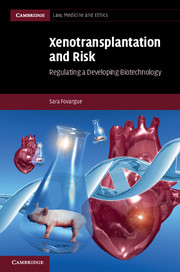Book contents
- Frontmatter
- Contents
- Acknowledgements
- 1 Introducing the issues
- 2 Dealing with risk
- 3 Regulating experimental procedures and medical research
- 4 Regulatory responses to developing biotechnologies
- 5 Challenges to legal and ethical norms: first-party consent and third parties at risk
- 6 Surveillance and monitoring: balancing public health and individual freedom
- 7 Summary and concluding thoughts: looking to the future
- Bibliography
- Index
2 - Dealing with risk
Published online by Cambridge University Press: 05 December 2011
- Frontmatter
- Contents
- Acknowledgements
- 1 Introducing the issues
- 2 Dealing with risk
- 3 Regulating experimental procedures and medical research
- 4 Regulatory responses to developing biotechnologies
- 5 Challenges to legal and ethical norms: first-party consent and third parties at risk
- 6 Surveillance and monitoring: balancing public health and individual freedom
- 7 Summary and concluding thoughts: looking to the future
- Bibliography
- Index
Summary
The concept of risk is central to my argument that xenotransplantation cannot necessarily or automatically be accommodated within existing legal and ethical norms. The consequences of clinical genetically engineered solid organ xenotransplants are events of the future as none have yet been performed. Their benefits and harms are uncertain. If such clinical xenotransplants prolong the recipient's life, then the benefit to them, their relatives and society is clear; spending on alternative treatments can be reduced, early deaths prevented, hospitalisations reduced, and recipients can enter or remain in employment. Xenotransplants would also eliminate consent issues raised by human donation, provide an unlimited source of organs, enable operations to be performed at the optimum time, and recipients may require reduced levels of immunosuppression compared to allotransplants. However, in xenotransplanting these organs into humans, infectious diseases may be transmitted to the recipient, their close contacts and the public. This possibility is widely acknowledged but there is no consensus on its nature or extent, nor can it be quantified without clinical experience. When the risks of a biotechnology may significantly impact on the health of individuals and society they should not be ignored; particularly where its nature and extent could be severe. Such risks are outside most of our experiences as they are largely unknown and unidentifiable, their extent unclear, possibly latent, and not confined or confinable to the xeno-recipient or one country. Xenotransplantation is thus an example of Beck's global and invisible risks of the risk society.
An overview of the science and risks of xenotransplantation set the foundations for this book, and I consider risk assessment (evaluation, communication and management) of unclear and unknown risks. Here, public understanding of and confidence in science is crucial and experiences with BSE, a cross-species disease, and GM crops, another developing biotechnology, are explored to see whether wider lessons can be learned from how these risks were communicated and managed. The risks of xenotransplantation also need to be considered in the context of the chronic shortage of human organs available for transplantation, and the pre-clinical and clinical results achieved to date. A pig heart has survived for 57 days, a liver for 8 and a kidney for 90 days in orthotopic life-supporting xenotransplants to non-human primates. Humans have survived for 9 months with a chimpanzee's kidney, 20 days with a baboon's heart and 70 days following a baboon's liver xenotransplant. But no solid organ non-human animal-to-human xenotransplant has been reported since 1993 and a genetically engineered solid organ is yet to be xenotransplanted into a human. It is thus questionable how those involved in clinical xenotransplants and the public can be advised about and protected from such risks. Effective risk management may be complicated by these unknowns, but a precautionary approach to risk, informed by Mill's harm principle, is required to safeguard public health. Issues of public health are particularly important where there is a disjunction between the potential individual beneficiary and those who may bear the burdens of a biotechnology. Xenotransplantation engages three aspects of interest in public health: that of ‘the public’ as a whole, the individuals who comprise the public, and the advancement of medicine. When regulating and managing xenotransplantation risks these interests should, as far as possible, be accommodated and the response proportionate given the possible benefits and risks. The public are crucial constituents of the decision-making process in determining this because of the risks they may be exposed to. Public participation in this process is thus necessary but if appropriate mechanisms are not (or cannot be) introduced, clinical xenotransplants should not proceed because without such it may directly benefit a limited few but jeopardise the health of more.
- Type
- Chapter
- Information
- Xenotransplantation and RiskRegulating a Developing Biotechnology, pp. 14 - 60Publisher: Cambridge University PressPrint publication year: 2011



